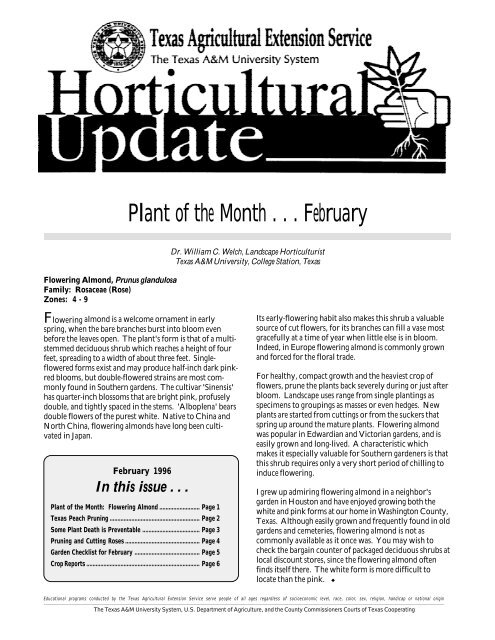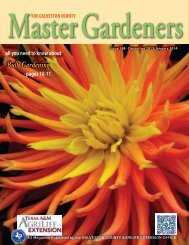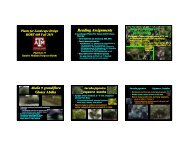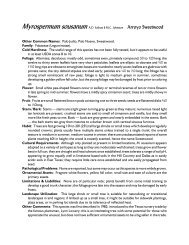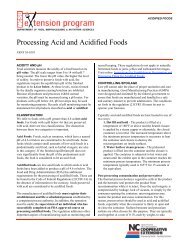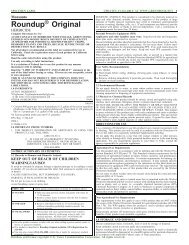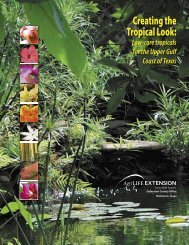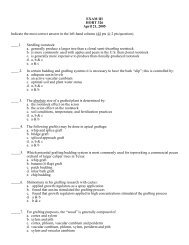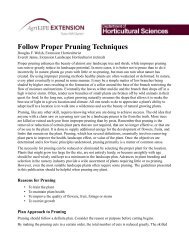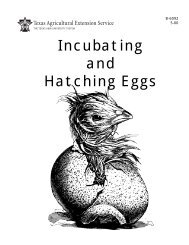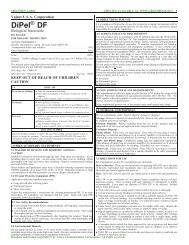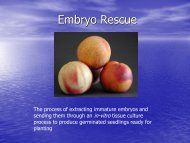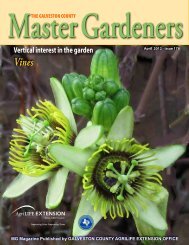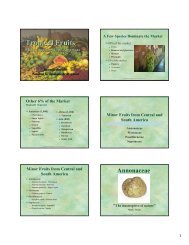Plant of the Month . . . February - Aggie Horticulture - Texas A&M ...
Plant of the Month . . . February - Aggie Horticulture - Texas A&M ...
Plant of the Month . . . February - Aggie Horticulture - Texas A&M ...
Create successful ePaper yourself
Turn your PDF publications into a flip-book with our unique Google optimized e-Paper software.
<strong>Texas</strong> Peach PruningGeorge Ray McEachern, Larry Stein, Nancy Roe, & Marty Baker, Extension Horticulturists<strong>Texas</strong> A&M University, College Station, <strong>Texas</strong>Peaches have beengrown in <strong>Texas</strong> forover a hundredyears. They havebecome establishedas a commercialcrop at Fredericksburg,Tyler, Mexia, Pittsburg,Wea<strong>the</strong>rford, and Montaguebecause <strong>of</strong> deep well-drainedsoil, varieties, chilling, and good orchard managers. Inaddition to <strong>the</strong>se factors, <strong>the</strong> performance <strong>of</strong> peach treesdepends heavily on proper pruning annually.Peach pruning is a hard labor-intensive cultural practicewhich is easy to avoid or compromise, but if trees are notpruned, <strong>the</strong> results are weak trees, overproduction, increaseddisease, and most importantly, short tree life.Peaches bloom and bear fruit on second-year wood;<strong>the</strong>refore, <strong>the</strong> tree needs to make good growth each springand summer to insure a crop for <strong>the</strong> next year. Each wintera large number <strong>of</strong> red 18- to 24-inch shoots need to bepresent as fruiting wood. If <strong>the</strong> trees are not prunedannually, <strong>the</strong> volume <strong>of</strong> fruiting wood reduces each yearand <strong>the</strong> fruiting shoots move higher and higher, becomingout <strong>of</strong> reach. Alternate-year pruning results in excessivegrowth <strong>the</strong> year following heavy pruning, so annualmoderate pruning is essential for <strong>the</strong> long-term control <strong>of</strong>tree vigor and fruiting wood.Timing Peach PruningLate-spring frost is <strong>the</strong> single greatest factor in <strong>Texas</strong> peachproduction, and <strong>the</strong> grower does not want to prune tooearly. The peach tree will bloom soon after pruning whenchilling is satisfied and warm wea<strong>the</strong>r follows. Growerswith only a few trees can wait until “pink bud” to prune.Large growers should not prune earlier than necessary.Pruning in <strong>Texas</strong> should be at least in <strong>February</strong> just prior tobloom in March.Objectives <strong>of</strong> Peach PruningThe main goal is to remove old grey-colored slow-growingshoots which are not fruitful and leave one-year-old red 18-to 24-inch bearing shoots. Removing 40 percent <strong>of</strong> <strong>the</strong> treeannually stimulates new growth each spring. The secondobjective is to lower <strong>the</strong> fruiting zone to a height which canbe hand-harvested from <strong>the</strong> ground. A third objective <strong>of</strong>peach pruning is to open <strong>the</strong> center <strong>of</strong> <strong>the</strong> tree; this allowsair to circulate, thus reducing disease pressure, and letssunlight into <strong>the</strong> tree to accelerate fruit color. Additionalobjectives <strong>of</strong> pruning are to remove diseased or deadshoots, rootstock suckers, and water shoots.Four Steps On How To Prune A Mature Peach TreeStep one: Remove all hanger shoots, rootstock suckers,and water shoots in <strong>the</strong> lower three feet <strong>of</strong> <strong>the</strong> tree. Thisstripping <strong>of</strong> lower growth clears a path for herbicideapplications and allows air circulation.Step two: Remove all shoots above seven feet in heighto<strong>the</strong>r than red 18- to 24-inch fruiting shoots. Cuts need tobe at selected points where <strong>the</strong> scaffold and sub-scaffoldlimbs extend upward at a 45 to 50 degree angle. Cutswhich leave limbs sideways at a 90 degree angle shouldbe avoided.Step three: Remove all shoots which grow toward <strong>the</strong>inside <strong>of</strong> <strong>the</strong> tree.Step four: Remove all old grey wood in <strong>the</strong> three- toseven-foot fruit production zone.Additional Hints on Pruning PeachesAlways remove bull shoots in <strong>the</strong> middle <strong>of</strong> <strong>the</strong> trees anytime <strong>the</strong>y develop. Summer pruning immediately afterharvest can help reduce bull shoots in <strong>the</strong> top <strong>of</strong> <strong>the</strong> tree.Wear gloves, long sleeves, eye protection, and a cap whichcovers <strong>the</strong> ears to prevent injury.Pruning paint is not needed.Peach pruning should remove 40 percent <strong>of</strong> <strong>the</strong> tree eachwinter. This reduces <strong>the</strong> number <strong>of</strong> fruit on <strong>the</strong> tree andstimulates strong growth <strong>of</strong> fruiting wood each year.The key to long peach tree life in <strong>Texas</strong> is deep welldrainedsandy soil, peach-tree borer and scale insectcontrol, weed control, and correct pruning. Fruiting willdepend on escaping spring frosts. ◆January 10, 19962HORTICULTURAL UPDATE FEBRUARY 1996
Some <strong>Plant</strong> Death is PreventableTed Fisher, County Extension Agent (<strong>Horticulture</strong>)<strong>Texas</strong> Agricultural Extension Service, Travis CountyHave you ever had a plant die, even one that you hadcarefully planted and pampered? Of course you have.<strong>Plant</strong>s die all <strong>the</strong> time; <strong>the</strong>y die on everyone, from <strong>the</strong>pr<strong>of</strong>essional horticulturist to <strong>the</strong> novice gardener. Regardless<strong>of</strong> <strong>the</strong> care we may give some plants, <strong>the</strong>y just don'tseem able to survive. And it may have been no cause <strong>of</strong>your own.<strong>Plant</strong> death can occur due to many factors. Some causes,such as freeze damage, may be readily identified, whileo<strong>the</strong>rs are more difficult to discover. Death by naturalcauses is not uncommon. Just expect a certain amount <strong>of</strong>this when plants are young, and again when <strong>the</strong>y havereached <strong>the</strong> end <strong>of</strong> <strong>the</strong>ir normal life span. When you planta large number <strong>of</strong> plants, expect a few to never establish.For example, when planting two dozen <strong>of</strong> <strong>the</strong> same species<strong>of</strong> landscape shrubs, it is not uncommon at all to have oneor two die in <strong>the</strong> first few weeks after planting. Don'tworry about it; it wasn't your fault. There was probablynothing you could have done to prevent it.Similarly, when any plant gets old, its growth rate slowsand it tends to become much more susceptible to insectand disease problems. These are problems that aredifficult to avoid, as nature takes it toll. There are,however, o<strong>the</strong>r problems and situations that are <strong>the</strong>avoidable kind. These can be categorized as follows:● Poorly adapted plants. Don't waste your time, labor,and money on plants not suited to your area. There aremany o<strong>the</strong>rs from which to select, including a multitude<strong>of</strong> outstanding native trees and shrubs.three years. This <strong>of</strong>ten happens during new homeconstruction where <strong>the</strong> repeated movement <strong>of</strong> heavyequipment under and around trees on <strong>the</strong> constructionsite can prove to be fatal due to soil compaction andresulting root damage.● Lack <strong>of</strong> deep watering. All plants, but especially newlyplanted trees and shrubs, need deep, thorough soakings.This is especially critical during <strong>the</strong> summer months.The best way to water woody plants is to lay your hoseunder <strong>the</strong> drip line, turn it on slowly, and soak <strong>the</strong> soilthoroughly. Simply watering <strong>the</strong> lawn or sprinkling <strong>the</strong>flower beds is not enough for your woody plants in hotwea<strong>the</strong>r.● Too much fertilizer. Over-fertilization by overzealousgardeners can deal a fatal blow to landscape plants. Usefertilizer with care and caution, especially during hotwea<strong>the</strong>r, and always read and follow <strong>the</strong> manufacturer'sdirections on <strong>the</strong> bag or box.● Failure to mulch. Research indicatesmulching does more to help new plantsestablish than any o<strong>the</strong>r single factor. Aheavy mulch applied around newlyplanted or established trees and shrubswill work wonders and help to ensuresurvival and improved growth. Whatto use? Pine bark, grass clippings, pineneedles, compost, straw, hay -- all areexcellent. ◆● Transplanting at <strong>the</strong> wrong time. While we can buy andplant balled-and-burlapped and container-grown nurserystock year-round, we should only dig up and transplantestablished plants in December, January, or <strong>February</strong>when <strong>the</strong> plants are dormant. When digging andtransplanting plants, it is essential that you prune afourth to one-half <strong>of</strong> <strong>the</strong> canopy on transplanted materialsto bring <strong>the</strong> top into balance with what is left <strong>of</strong> <strong>the</strong>damaged root system.● Excessive fill over feeder roots. Adding more than sixinches <strong>of</strong> heavy clay soil over <strong>the</strong> feeder roots <strong>of</strong> treeswill <strong>of</strong>ten suffocate and kill established trees in two or3HORTICULTURAL UPDATE FEBRUARY 1996
✔Garden Checklist for <strong>February</strong>Dr. William C. Welch, Landscape Horticulturist<strong>Texas</strong> A&M University, College Station, <strong>Texas</strong>Don't fertilize newly set out trees or shrubs until after <strong>the</strong>y have started to grow, and <strong>the</strong>n only very lightly, <strong>the</strong> firstyear.When buying plants, <strong>the</strong> biggest is not always <strong>the</strong> best, especially with bare-rooted plants. The medium to smallsized (4 to 6 feet) usually become established faster and will become effective in <strong>the</strong> landscape more quickly than<strong>the</strong> large sizes.Complete <strong>the</strong> bare-root planting <strong>of</strong> woody landscape plants this month. Container and ball-and-burlapped plantsare in good supply and can be set out most any time. Winter and early spring planting provides an opportunity forgood establishment before hot wea<strong>the</strong>r comes.Prune roses during <strong>February</strong> except in <strong>the</strong> Panhandle and far North <strong>Texas</strong>, where roses are pruned in March orApril. Use good shears that will make clean cuts. Remove dead, dying, and weak canes. Leave four to eight healthycanes and remove approximately one-half <strong>of</strong> <strong>the</strong> top growth along <strong>the</strong> height <strong>of</strong> <strong>the</strong> plant.Now is an excellent time to select and plant container-grown roses to fill in bare spots in your rose garden.Wait until after <strong>the</strong>y finish flowering before pruning spring-flowering shrubs such as quince, azalea, and forsythia.When pruning shrubs, follow <strong>the</strong>se steps: (1) prune out any dead or damaged branches first; (2) thin out by removingabout one-third <strong>of</strong> <strong>the</strong> canes or stems at ground level, removing <strong>the</strong> oldest canes only; (3) shape <strong>the</strong> rest <strong>of</strong> <strong>the</strong>plant but do not cut everything back to <strong>the</strong> same height.<strong>Plant</strong> dahlia tubers in late <strong>February</strong> and early March.<strong>Plant</strong> gladiolus corms; space planting dates at two-week intervals to extendflowering season.Fertilize pansies once again for continued flowering. Don't forget to waterwhen needed.A potted plant, tree, shrub, or cut flowers make excellent Valentine giftsfor loved ones and shut-ins. ◆5HORTICULTURAL UPDATE FEBRUARY 1996
Crop ReportsU. S. PECAN CROP. The U.S.D.A. has revised <strong>the</strong> total U. S. pecan crop estimate to 239 million pounds, down from <strong>the</strong> initialforecast <strong>of</strong> 248 million. Even so, this estimate is still some 40 million pounds over <strong>the</strong> 1994 crop.TEXAS CITRUS CROP DOWN. The <strong>Texas</strong> citrus crop estimate was revised by <strong>the</strong> U.S.D.A. in early December, and <strong>the</strong> newforecast reflects what many in <strong>the</strong> industry have been saying about lower production. The grapefruit volume was reduced from an initial200,000 tons to 176,000 tons -- 10,000 tons lower than last year's production.The early orange estimate was reduced from an initial 43,000 tons to 38,250 tons, some 2,125 tons below last season's crop. The Valenciaestimate was reduced from 9,000 tons to 6,375 tons -- still considerably above last year's 4,462-ton Valencia crop. Because <strong>the</strong> Valenciacrop estimate is still ra<strong>the</strong>r optimistic, <strong>the</strong> total <strong>Texas</strong> orange crop is currently about <strong>the</strong> same as last year.Julian W. Sauls, Pr<strong>of</strong>essor and Extension HorticulturistGet on <strong>the</strong> information superhighway -- access <strong>Aggie</strong> <strong>Horticulture</strong> on <strong>the</strong> Worldwide Web at:HTTP://AGGIE-HORTICULTURE.TAMU.EDUHorticultural Update is published by Extension <strong>Horticulture</strong>, <strong>Texas</strong> Agricultural Extension Service, The <strong>Texas</strong> A&M University System, College Station, TXCONTRIBUTING EDITORSDrs. Samuel D. Cotner, Vegetables; Calvin G. Lyons, Fruits; George F. McEachern, Pecans & Grapes; William C. Welch, Landscape; Douglas F. Welsh, LandscapeEDITOR FEBRUARY 1996Douglas F. Welsh, Landscape Horticulturist


